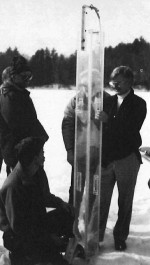Synthesis is more than pulling things together: it is also the search for new generalization and new theory
Synthesis is a tradition in the ecological sciences. In LTER we have a greater opportunity to take a broader view than almost any other ecological research program. We have both the challenge and the facilities to cross traditional barriers to more holistic thinking and generalization. We can synthesize across ecosystems so disparate that, owing to differences in the schooling of their scholars, synthesis has been inhibited between forest and grassland ecology, limnetic and lotic aquatic ecology, and aquatic, freshwater, marine and terrestrial ecology. We can synthesize across a wide variety of streams or forests scattered across the continent and beyond. We can evaluate species in a population context, a community context, an ecosystem context, a landscape context, or all of these. The possibilities seem open-ended, and may be limited only by our creativity or resolve to take advantage of a unique opportunity. Synthesis is more than pulling things together: it is also the search for new generalization and new theory.
There are a number of scientific, social and administrative realities of the LTER Program that have created this opportunity. On the science side, we carry out synthesis on data from our own projects, we are asking similar questions in a wide variety of landscapes, we have similar sets of measurements in the same core areas, such as primary production, biogeochemistry, and fluctuations in populations. We have accessible data which, after due acknowlegement to individual scientists, is common property. On the social side, we routinely talk and walk and dine with ecologists different from ourselves; our association causes us to pay attention to a broader array of areas, topics and scientific ideas. On the administrative side, we have a network for communication and planning, a meaningful peer review system to maintain quality, and some common funding to apply new technologies.
At the winter 1992 Coordinating Committee meeting at Trout Lake, Wisconsin in a session we co-chaired, site representatives reviewed recent explorations in synthesis and considered future activities. We were interested in learning what features of LTER or our recent efforts have contributed to or detracted from synthesis, and what new ideas might emerge. Current synthesis efforts include work in the areas of:
- Process Studies. Synthesis across LTER projects includes the processes of decomposition, biogeochemistry of soils, and terrestrial net primary production.
- Climate Forcing. Climate change is a reasonable forcing function for testing the reality of any of our models; the computing time required for analyses of global circulation models at a spatial scale meaningful to ecologists suggests that LTER may need close ties to global circulation modeling groups, and may need to develop special projects to generate site-specific climate data.
- Analyses of Temporal and Spatial Data. LTER’s rich data sets allow us to be creative in developing new ideas and new questions from comparisons such as the use of variability to characterize ecosystems.
- Scaling up to Continental and Global Levels. Large spatial data bases on climate and soils are being placed in geographic information systems (GIS) and combined with models to evaluate regional responses to climatic variation.
Examples were presented of models that run at continental and global scales. These process models of ecosystem productivity can be used to simulate primary production; they can be linked with GIS and their predictions checked against remote sensing of vegetation properties such as NDVI. They can be run at several different scales using vegetation type, soils, temperature, precipitation, and cloud data, and can predict how processes of present-day ecosystems will respond to global change. Models and GIS sufficient to synthesize our knowledge over regional and continental scales are already in place across the LTER Network.
Ideas for potential future activities emerged from working groups, including: the influence of animals on ecosystem processes using stable nitrogen isotopes, belowground processes and soil health, hydrological responses to climate variations such as El Niño, biological diversity of microbial communities in soils of terrestrial, freshwater and marine ecosystems, the relation between biological diversity and ecosystem processes in a gradient from desert to grasslands, and trend analysis of ice cover and physical limnology of northern hemisphere lakes.
Clearly we have made progress in synthesis in the LTER Program since former NSF Division of Biotic Systems and Resources Director John Brooks challenged us in 1988 to take advantage of our unique resources for synthesis. Research opportunities exist in the commonalties of the sites’ common data, common processes, common forcing functions, common questions, common tools (approaches and methods), and common funding. These shared features could lead to some of the most uncommon advances to ecological science in the next decade.
John E. Hobbie, Arctic Tundra
John J. Magnuson, North Temperate Lakes


 Enlarge this image
Enlarge this image